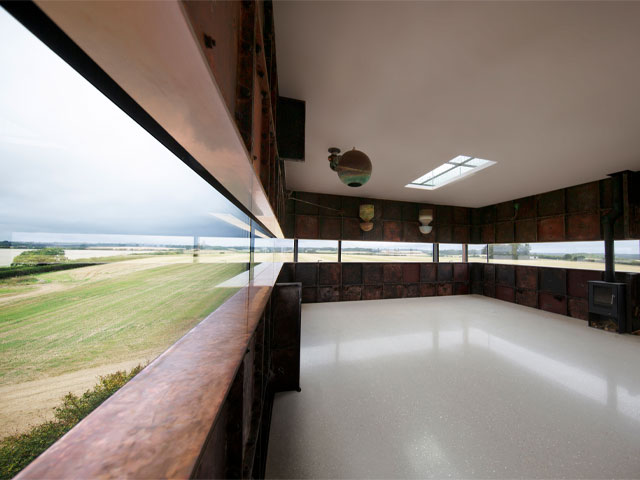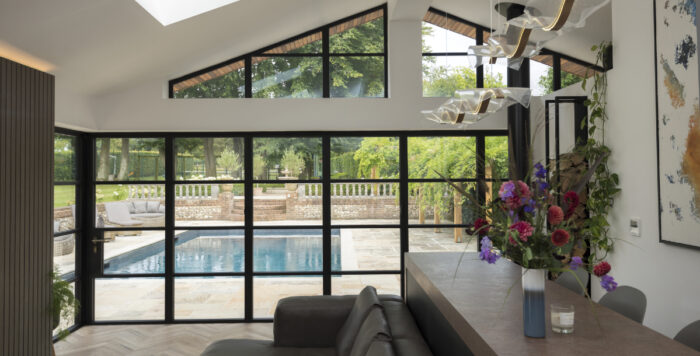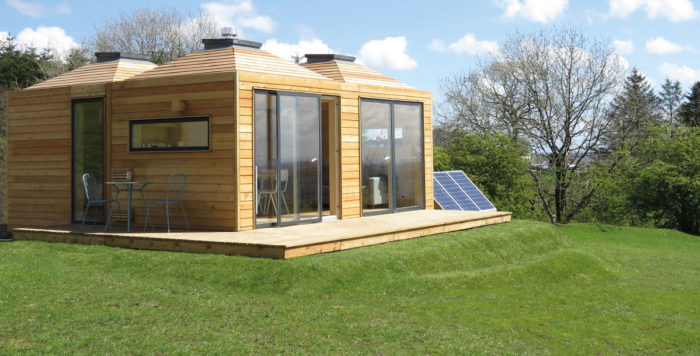5 homes that take you by surprise
The first five RIBA candidates to hit the small screen on Grand Designs: House of the Year 2021
These five homes all take you by surprise, unfurling to reveal details that you didn’t expect. They all featured on Grand Designs: House of the Year 2021, vying for the coveted RIBA award.
Kevin McCloud, architect Damion Burrows and design expert Michelle Ogundehin tour the UK for the new series, and in this episode, airing on Wednesday 17 November at 9pm on Channel 4, they visit homes in Gloucestershire, Norfolk, London, Cumbria and the Hampshire coast.
1. House on the Hill, Gloucestershire
House on the Hill took more than 10 years, in what can only be described as a labour of love by client and architect working cohesively. The small 18th century farmhouse, located at the highest point of Gloucestershire, was transformed into a home and a gallery by Alison Brooks Architects.
The first phase of the four-phase project converted the original farmhouse, uniting three stores on side to create a lofty but intimate display room for the collection of Indian and African sculpture. The original stairs remain, linking a series of small rooms and culminating in a suspended landing. The extension, larger than the original house, is clad in deep brown fibre cement to recall the darkness of the nearby Forest of Dean, counterpointed by small flashes of highly polished stainless steel.
The project enhances an already lovely setting, with landscape treatment all around the house connecting it with the garden. Michelle complemented the ‘precision and detail of the architecture’, saying ‘there are lots of things that shouldn’t really work here, but they do’.
Find out more at architecture.com

House on the Hill by Alison Brooks Architects. Photo: Paul Riddle
2. House-within-a-House, London
Michelle and Dan wanted a home for their five boys, and this three-storey, six bed, detached family home in a conservation area of south London had the space. The original Victorian home was destroyed in WWII and replaced by a nondescript building in the 1960s, so London-based architecture practice alma-nac decided to build around the existing two-storey house, effectively giving the house a new skin to bring it up to contemporary standards and blend the structure with its neighbours.
Many of the inner walls were retained and skilfully integrated into the new house, while roof and rear extensions are made mostly of lightweight, exposed timber. The inside is not entirely open plan. Two rooms to the front, which could be used as a study and a snug, look onto the front garden. The living quarters are split level – the sitting room stepping down to the single storey kitchen and dining room at the back, which looks over the rear garden.
Kevin McCloud called it ‘a fabulously proud 21st century conversion of next door’.
Find out more at architecture.com

House-within-a-House by alma-nac. Photo: Jack Hobhouse
3. Pele Tower House, Cumbria
Katie Woolacott and Patrick Gilmartin enlisted Woollacott Gilmartin Architects to transform a Grade II listed fortress into a family home full of light.
The conversion displays considerable inventiveness and sensitivity. The character of the 14th century Pele Tower – a memorable and long-standing feature of the site – has been successfully retained by deeply recessing new glazing within the massive depth of the walls. The works have also enhanced the landscape, removing modern farming structures and hard surfaced areas.
The environmental performance of the existing buildings have also been upgraded to modern standards of insulation, air tightness and thermal bridging. Renewable energy is generated from ground-source heat pumps and a micro-hydroelectric scheme, producing more energy than the house consumes, further reducing its carbon footprint.
Find out more at architecture.com

Pele Tower House by Woollacott Gilmartin Architects. Photo: Luke White
4. The Water Tower, Norfolk
This Norfolk water tower conversion by Tonkin Liu is certainly worthy of RIBA recognition. Dennis and Misia brought the derelict structure back to life as a family home, with a ground-floor kitchen/dining room, bedrooms on the first and second floors, and an upper living/dining/kitchen tank room at the top. The accommodation sits in the north tower, linked to the south tower helical stairwell by a glazed ‘bridge’.
Each room enjoys a fully glazed elevation looking out across arable fields, and the new structure is made from cross-laminated timber (CLT), left exposed on the interior to lend warmth to the building. Exposed metal panels from the plant room, complete with the original ballcocks and valves, are retained as decorative features. The effort to preserve and retain as much of the original structure as possible shows how good retrofitting design can combine low embodied energy and architectural delight.
Design expert and co-presenter Michelle Ogundehin compared the water tower house to ‘a Bond-lair’.
Find out more at architecture.com

Norfolk Water Tower by Tonkin Liu. Photo: Dennis Pedersen
5. Harbour House, Hayling Island
Hayling Island, just off the south coast in Hampshire, is an upside-down house by John Pardey Architects. On the ground floor are three bedrooms, a wet room and a family room. Upstairs, the open-plan kitchen, living and dining room area, as well as the master bedroom, are positioned to make the most of the views.
Described by Kevin McCloud as ‘handsome, angular and well-chiseled’, the property features plenty of nautical references, from horizontally proportioned windows to white cladding and strip-timber floors and ceilings.
To make the most of the spectacular surrounds, Harbour House has a generous first-floor terrace, connected to a pool set into the garden by an external staircase. It’s home to Simon and Lisa, who met by the sea, got married at sea and wanted to live by the sea.
Find out more at architecture.com

Harbour House by John Pardey Architects. Photo: James Morris
Which of these five properties will make it onto the RIBA House of the Year shortlist? Tune into Channel 4 to find out…
See the first set of homes competing for a place on the shortlist for @RIBA‘s #HouseOfTheYear award on @Channel4 at 9pm tomorrow!#GrandDesigns🏠 pic.twitter.com/8mYXQdj957
— granddesigns (@granddesigns) November 16, 2021









